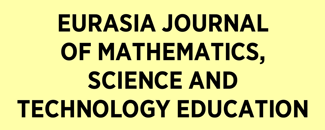Archives
Current issue
About
About us
Aims and Scope
Abstracting and Indexing
Editorial Office
Open Access Policy
Publication Ethics
Journal History
Publisher
Follow us: Twitter
Contact
For Authors
Editorial Policy
Peer Review Policy
Manuscript Preparation Guidelines
Copyright & Licencing
Publication Fees
Fee Waiver Policy for Doctoral Students
EJMSTE Language Editing Service
More
Statistics
Special Issues
Special Issue Announcements
Published Special Issues
RESEARCH PAPER
A New E-learning Model Based on Elastic Cloud Computing for Distance Education
1
School of Information, Central University of Finance and Economics, Beijing 100081, CHINA
2
Business School, Beijing Normal University, Beijing 100875, CHINA
Online publication date: 2017-11-25
Publication date: 2017-11-25
EURASIA J. Math., Sci Tech. Ed 2017;13(12):8393-8403
KEYWORDS
ABSTRACT
The development of information technology has a positive influence over distance education. For instance, it gives birth to E-learning, a novel and convenient mode of online learning. However, the existing E-learning platforms are often in need of heavy infrastructural investment. To solve the problem, this paper introduces the architecture of elastic cloud computing to E-learning, and proposes a new load balancing algorithm based on elastic cloud computing. Then, it establishes a five-layer elastic cloud-based E-learning model for distance education. The subsequent evaluation demonstrates that the model can effectively respond to the dynamic load imposed on by numerous users, and maximize the revenue of the E-learning platform.
REFERENCES (21)
1.
Alavi, E., & Mohan, M. C. (2013). An E-Learning System Architecture Based on New Business Paradigm Using Cloud Computing. International Journal of Engineering Sciences & Research Technology, 2, 17-28.
2.
Al-Dhuraibi, Y., Paraiso, F., & Djarallah, N. (2017). Elasticity in Cloud Computing: State of the Art and Research Challenges. IEEE Transactions on Services Computing, 99, 1-9.
3.
Arpaci, I. (2017). Antecedents and consequences of cloud computing adoption in education to achieve knowledge management. Computers in Human Behavior, 70, 127-132.
4.
Bhatt, M., Rahayu, W., & Soni, S. P. (2009). Ontology driven semantic profiling and retrieval in medical information systems. Web Semantics Science Services & Agents on the World Wide Web, 7(4), 317-331.
5.
Chuang, S. M., Chang, K. E., & Sung, Y. T. (2011). The cost effective structure for designing hybrid cloud based enterprise E-learning platform. IEEE International Conference on Cloud Computing and Intelligence Systems, IEEE, 523-525.
6.
Dong, B. (2009). BlueSky Cloud Framework: An E-learning Framework Embracing Cloud Computing. Cloud Computing Proceedings, 5931, 577-582.
7.
Duan, Y., Fu, G., & Zhou, N. (2015). Everything as a Service (XaaS) on the Cloud: Origins, Current and Future Trends. International Conference on Cloud Computing, IEEE, 621-628.
8.
Greer, D. L., Crutchfield, S. A., & Woods, K. L. (2013). Cognitive Theory of Multimedia Learning, Instructional Design Principles, and Students with Learning Disabilities in Computer-Based and Online Learning Environments. Journal of Education, 193, 41-51.
9.
Kulshrestha, V., & Verma, S. (2013). Analyze the Future: Cloud Computing, a New Phase in Information Technology Infrastructure Management. International Journal of Computers & Technology, 11(6), 43-49.
10.
Lucas, J. M., Saccucci, M. S., & Woodall, W. H. (1990). Exponentially weighted moving average control schemes: properties and enhancements. Technometrics, 32(1), 1-29.
11.
Masud, M. A. H, & Huang, X. (2012). An E-learning System Architecture based on Cloud Computing. System, 6, 65-74.
12.
Mell, P., & Grance, T. (2009). The NIST definition of cloud computing. Communications of the Acm, 53(6), 50-50.
13.
Moreno, R., & Mayer, R. E. (1999). Cognitive principles of multimedia learning: The role of modality and contiguity. Journal of Educational Psychology, 91(2), 358-368.
14.
Peng, S., Zhang, M., & Niu, X. (2008). Magnetically responsive elastic microspheres. Applied Physics Letters, 92(1), 5492-5498.
15.
Phankokkruad, M., & Woraratpanya, K. (2008). Web Service Architecture for Computer-Adaptive Testing on e-Learning. Proceedings of World Academy of Science Engineering & Technology, 46, 347-358.
16.
Praveena, K., & Betsy, T. (2009). Application of Cloud Computing in Academia. Social Science Electronic Publishing, 25(2), 101-104.
17.
Shanmugapriya, M., & Tamilarasi, A. (2012). Developing a Mobile Adaptive Test (MAT) in an M-Learning Environment for Android Based 3G Mobile Devices. International Journal on Computer Science & Engineering, 4(2), 153-161.
18.
Shri, M. L., & Subha, S. (2013). An implementation of E-learning system in private cloud. International Journal of Engineering & Technology, 5(3), 3036-3040.
19.
Thyagharajan, K. K., & Nayak, R. (2007). Adaptive content creation for personalized E-learning using web services. Journal of Applied Sciences Research, 3(9), 828-836.
20.
Wang, L., Laszewski, G. V., & Younge, A. (2010). Cloud Computing: a Perspective Study. New Generation Computing, 28(2), 137-146.
21.
Xu, Z., Yin, Z., & Saddik, A. E. (2003). A Web services oriented framework for dynamic e-learning systems. Electrical and Computer Engineering, 2, 943-946.
Share
RELATED ARTICLE

